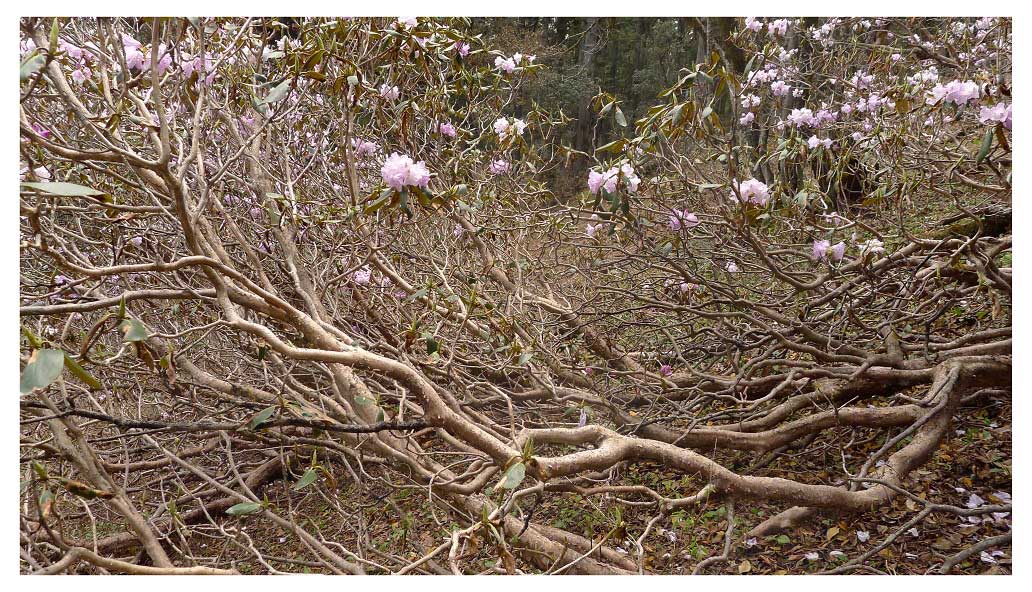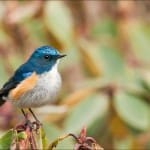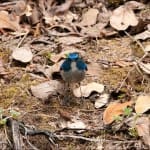What do you call a bird with no name? Or one whose name has been changed lately? Such questions such briefly but subside when confronted with the dazzling beauty of the Himalayan Bluetail — or whatever they called it earlier

Before I tell you about the Himalayan Bluetail I must briefly talk about another bird – the Orange-flanked Bush-robin (Tarsiger cyanurus) since that’s how we knew it when I and Bijoy saw it first. We were at Tungnath (approx. 3600 mts) in late September 2009. It was the fag-end of the monsoons, and we already had appeased the forces with our customary drenching-while-birding lower down at Chopta.
It was patch of Dwarf Rhododendron below the temple, just off the pilgrim path leading to the shrine. We were looking for Himalayan Monals and hoping to sight the Golden Bush Robin (Tarsiger chrysaeus). I had a touch of altitude sickness – nauseated and feverish – when I saw a small bird hopping on the rhododendron understory and a flash of orange. I lost no time and shouted out to Bijoy: “Golden Bush Robin!” It was more of a wish than considered birding observation but he was interested. However, the bird was gone. But now we had something to look for.

Soon enough it appeared again – it was not golden but stunning nevertheless. It was a small robin-like bird with an erect robin-like stance but which flitted about the thick undergrowth like a flycatcher (though we never saw a sortie). The little blue bird with the white underside and a blazing orange whoosh on the flank – at the border of the blue and the white halves of its body — was an absolute stunner. It was a lovely moment in our birding journey, which we later celebrated with the crispiest parathas ever, at Shiva’s abode.
I had to wait three years for the next encounter – this time it was the Himalayan Bluetail (Tarsiger rufilatus).

Just below the gorgeous campsite at Dhel Thatch (3,700 mts) in the Great Himalayan National Park is an enchanting forest of oak with thick clumps of dwarf rhododendron. This time of the year, rhododendron was in full bloom and laden with white, lilac and soft pink blossoms. As Sandy and I passed the last patch that opened towards the meadow, we saw it again. The bird with an iridescent blue mask (something I had missed in the first sighting) on its deep blue face flitted about at the base of the rhododendron stalks.

We had a top-view of the bird – a Prussian blue hourglass fringed with orange terminating in a flicking, deep-blue tail. As we peered through the understory the bird darted about in nervous excitement, crossed the path behind us, perched briefly on an oak, and came to the ground on the other side, completing a full circle. Then the female appeared. I was similar in size to the male with a blue tail, white belly and brown upperparts tinged with olive. The orange whoosh was not as bright as in the male (maybe an impression due to the absence of the blue) but it was a lovely bird in its own right.

Over the next three days at Dhel we saw it several times and always amidst the blooming rhododendrons. It fed like a robin – flying down to the ground, hopping and pecking at the soil. Once amidst the stalks it would fly around like a flycatcher but not as restlessly.

Note on the species split:
The Orange-flanked Bush-robin (Tarsiger cyanurus) is now called the Red-flanked Bluetail and is considered a vagrant to the Indian subcontinent.
The Himalayan Bluetail (Tarsiger rufilatus) is now nominally split from the above species and the one described in this article. It is also called the Himalayan Red-flanked Bush-robin (per Wikipedia).
The two species, though similar, differ hugely in their migratory behavior.
View the gallery
Text by Sahastrarashmi. Photographs by Sandeep Somashekharan
- Encounter: The Sacred Grove at Oorani - November 28, 2012
- Encounter: Rhododendron, sentinel of the highlands - October 7, 2012
- Manjhi Akshayavat, an immortal Banyan tree - July 17, 2012













Rarely see pink rhododendrons. Great pictures.
Thank you Anita! You’ll love our new post on Rhododendrons – http://greenogreindia.org/encounter-rhododendron/
Nice, even I hadn’t noticed the iridescent eye mask, but very evident in the photographs. Was very refreshing reading this and remembering the trip.
Neat bird and awesome photography! And I really appreciate the habitat photo too. Good thinking!
Bryan, thank you!
Do sign up for updates: http://eepurl.com/m-iHX